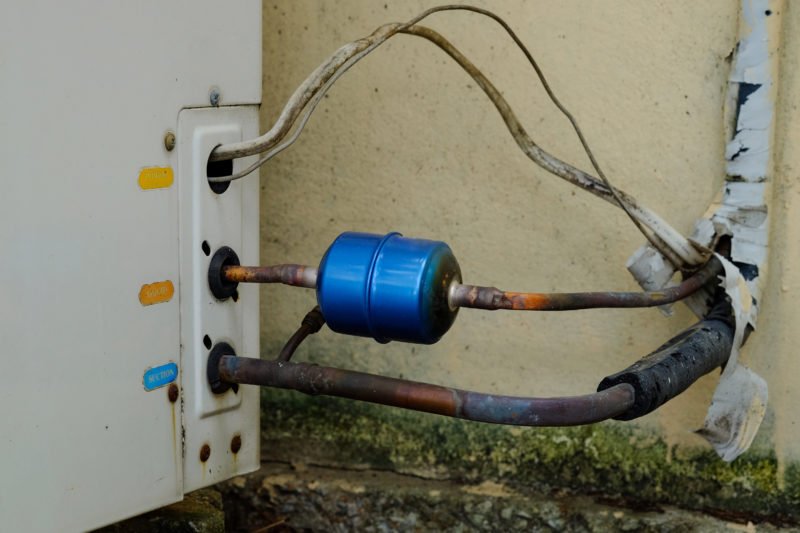Frozen AC Pipe - Identifying and Resolving the Issue Promptly
Frozen AC Pipe - Identifying and Resolving the Issue Promptly
Blog Article
Just how do you really feel about How can I fix an air conditioner’s frozen pipe??

Intro
Finding that your air conditioner pipeline is frozen can be worrying, especially during hot summer months when you depend on your ac unit the most. Understanding what to do in such a situation is critical to avoid additional damages to your air conditioning system and guarantee your convenience inside.
Recognizing the Causes
Numerous factors can contribute to the cold of an AC pipe. Comprehending these reasons can help you resolve the problem effectively.
Lack of Airflow
One usual cause of a frozen air conditioning pipeline is inadequate air flow. When the air movement over the evaporator coil is limited, it can create the coil to drop below freezing temperature, resulting in ice development on the pipeline.
Low Refrigerant Levels
Insufficient cooling agent levels in your air conditioner system can likewise cause an icy pipe. Reduced cooling agent levels can trigger the stress in the system to go down, bring about the freezing of wetness on the evaporator coil.
Cold Weather Conditions
In colder environments, freezing temperatures outside can contribute to the freezing of a/c pipelines. If your a/c unit is not properly insulated or if there are leakages in the ductwork, cold air can infiltrate the system, causing the pipeline to freeze.
Dirty Air Filters
Filthy or clogged up air filters can restrict air movement in your AC system, resulting in numerous problems, including an icy pipe. It's essential to change or clean your air filters regularly to guarantee appropriate airflow and avoid ice buildup.
Indications of a Frozen A/c Pipe
Identifying the indicators of an icy air conditioner pipe is vital for prompt activity.
Reduced Airflow
If you discover a considerable decline in air flow from your vents, it might indicate an icy pipeline.
Ice Buildup on the Pipe
Noticeable ice build-up on the cooling agent line or the evaporator coil is a clear sign of an icy a/c pipeline.
Unusual Sounds from the Unit
Uncommon audios, such as hissing or bubbling, coming from your a/c unit can signify that there's ice present on the pipeline.
Immediate Actions to Take
When confronted with an icy air conditioner pipe, it's essential to act swiftly to avoid further damages to your cooling system.
Switching off the air conditioning
The primary step is to turn off your a/c to prevent the system from running and worsening the concern.
Checking for Blockages
Evaluate the location around the indoor device for any kind of obstructions that may be obstructing air flow, such as furniture or drapes.
Defrosting the Pipe
You can make use of mild approaches like positioning towels taken in warm water around the frozen pipe to aid thaw it gradually.
Safety nets
Taking preventive measures can assist prevent future occurrences of an icy air conditioner pipeline.
Routine Maintenance Checks
Schedule normal maintenance talk to a specialist HVAC professional to guarantee that your AC system is running successfully.
Changing Air Filters
Regularly change or cleanse your air filters to avoid air movement restrictions and keep optimal efficiency.
Insulating Exposed Pipes
If your air conditioning pipelines are exposed to chilly temperature levels, consider insulating them to avoid cold throughout winter months.
Looking For Professional Help
If DIY methods fail to fix the concern or if you're unclear regarding just how to continue, it's best to look for aid from a certified HVAC service technician.
When DIY Methods Fail
If your efforts to thaw the pipeline or address other issues are not successful, it's time to call a specialist.
Relevance of Hiring a Professional HVAC Technician
A certified HVAC service technician has the proficiency and tools needed to diagnose and fix issues with your a/c system safely and effectively.
Final thought
Taking care of an icy a/c pipeline can be a discouraging experience, yet knowing just how to respond can assist reduce damages and bring back convenience to your home. By understanding the causes, identifying the indicators, and taking punctual action, you can effectively resolve the concern and avoid future occurrences.
What to Do If Your AC Line Is Frozen
Make Sure All Supply and Return Air Vents Are Open
If you notice problems with airflow, the first thing you should do is check your supply and return vents. Supply vents distribute clean, conditioned air throughout your home. As this air becomes stale, it’s pulled into the return vent, where it’s reconditioned before being sent back out through the supply vent.
When these vents are closed, air won’t flow in the home. Before examining your AC, check the vents in every room and ensure they’re all open.
Check for a Dirty Air Filter
Another possible cause of limited airflow is a dirty air filter. Your air conditioner’s filters catch elements you don’t want to breathe in, such as dirt and dust. Over time, filters can become clogged, ultimately blocking air from flowing in and out. The lack of airflow can then cause the entire coil to freeze and will completely restrict any air from moving through it. The AC may need to be powered off for one to two days to allow the coil to thaw after replacing the filter to allow proper functioning of the unit. This debris can also accumulate on your AC’s evaporator coil, requiring a more serious repair. In general, air filters should be cleaned regularly (about every two weeks).
Assess Your Outdoor Unit
In addition to checking your AC, assessing the outdoor unit is a good idea. Also known as the condensing unit, it works with your interior unit to release heat outside. An issue with the outdoor unit can result in rising internal temperatures.
Overgrown Shrubs or Clogged Leaves
From leaves and twigs to shrubs and debris, there’s no shortage of outdoor elements that can accumulate around your condensing unit. When these elements get lodged inside the unit, they can block airflow. Fortunately, removing the blockage can solve the problem.
Sounds of a Broken Fan
Shrubs and leaves aren’t the only things that can impede your outdoor unit’s airflow. If the fan is broken, the unit won’t be able to properly get rid of heat — which means the internal temperature won’t go down. First, make sure the fan is spinning. If it is, check for the following sounds of a broken fan:
Buzzing Rattling Screeching Hissing Clicking Preventative Measures
Nobody wants to deal with a frozen AC line. In addition to causing problems with your air conditioner, they require professional repairs. On the bright side, there are preventative measures you can take to help ensure this issue doesn’t arise in the first place.
https://www.coopergreenteam.com/blog/what-to-do-if-ac-line-frozen

I'm very excited about How can I fix an air conditioner’s frozen pipe? and I'm hoping you liked our piece. You should take the time to promote this blog if you appreciated it. Many thanks for taking the time to read it.
Recurring Service Plans Report this page